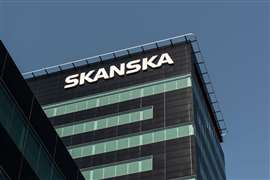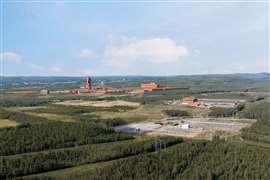Wood for data centres? This tech giant is relying on mass timber to achieve carbon goals
05 November 2024
The data centre construction market is exploding and expanding globally with no end in sight. The planet’s need to increase technology infrastructure is accelerating, driving sustainability initiatives in data centres to offset carbon emissions. One US-based tech giant is turning to a more traditional material to help realise its goals.
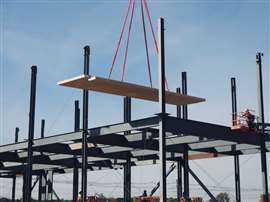 Cross-laminated timber is placed for a Microsoft data centre under construction in northern Virginia. (Image courtesy of Microsoft)
Cross-laminated timber is placed for a Microsoft data centre under construction in northern Virginia. (Image courtesy of Microsoft)
Microsoft touted its use of mass timber, or cross-laminated timber (CLT), across its network of recent data centre builds. While the company didn’t share how many of its more than 300 data centres in 34 countries have used mass timber, it highlighted alleged embodied carbon reductions in ‘two new data centres projects’ using a combination of CLT, steel and concrete.
“The hybrid mass timber, steel and concrete construction model is estimated to significantly reduce the embodied carbon footprint of two new data centres by 35% compared to conventional steel construction, and 65% compared to typical precast concrete,” said Microsoft.
Data centres are usually large facilities with thick walls and ceilings constructed to increase security and remove the impact of exterior elements to protect servers and data banks inside. The centres are often windowless and made mostly of steel and concrete, in part due to the heat the computers give off inside.
While traditional wood is not considered an ideal material within a data centre due to said heat, CLT mass timber is a highly engineered and prefabricated wood-based material that’s fire-resistant and lighter than steel (which it most typically replaces in hybrid mass-timber constructions).
Garrett DeRooy, a project manager and estimator in the US for Canada-based PCL Construction — who has extensive experience with and knowledge of mass timber buildings in the Seattle, Washington area — helped explain for Construction Briefing the processing that gives mass timber a perceived advantage. “It’s either glued together or nail-laminated timber… when you start putting those together, they get really good structural properties more similar to what you see in traditional concrete and steel structures.”
DeRooy added the product can produce high-quality spans, beams, and columns, and the material has been popular in new residence developments for its biophilic appearance.
But strength testing has shown the product could be reliable in industrial builds, too.
“It’s very strong,” added DeRooy. “In vertical loading and then on the panels, we’ve come to find out that as you cross laminate the pieces of wood, you can get some interesting strength properties there.”
Data centre expansion cutting into emissions reduction gains
 The exterior of a Microsoft facility. (Image: Adobe Stock)
The exterior of a Microsoft facility. (Image: Adobe Stock)
While the emerging material’s unique combination of strength and manoeuvrability make it appropriate for data centres, it’s not driving Microsoft’s decision to incorporate mass timber.
Instead, to meet its own carbon reduction goals, the company said it needed to find an alternative means to raise up its future data houses.
“In May, Microsoft announced it had achieved a 6.3% reduction in direct emissions over three years. But indirect emissions increased 30.9%, driven by the growth of data centres and the hardware housed inside,” said the company. “Indirect emissions are particularly difficult to manage since they include carbon emitted during extraction, processing, manufacturing and even transportation of materials, and so are outside Microsoft’s direct control.”
The strategy is by no means unique to the US tech firm, which it acknowledged.
“Cross-laminated timber, a staple of low-carbon building in the European Union that has only recently begun to catch on in the US, is being put to the test in what Microsoft believes is one of the first hyperscale examples of engineered wood in a US data centre,” Microsoft said.
Mass timber has hurdles to mass adoption in US
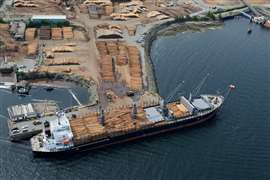 Aerial photo of a northern bleached softwood kraft (NBSK) pulp mill located on the east coast of Vancouver Island near Nanaimo, British Columbia, Canada. (Image: Adobe Stock)
Aerial photo of a northern bleached softwood kraft (NBSK) pulp mill located on the east coast of Vancouver Island near Nanaimo, British Columbia, Canada. (Image: Adobe Stock)
While Microsoft’s acceptance of the prefabricated material should certainly boost nationally some confidence in mass timber, there’s still significant barriers.
On the smaller end, cities and municipalities across America often have coding or zoning laws that unintentionally restrict the use of mass timber. Through the mid-1800s and into the 1900s, many major American cities required new properties be built with brick or stone, ultimately banning wood construction in urban settings throughout the US.
In most modern cases, though, mass-timber high-rises and developments have been given green lights in cities after specialised approval or after the municipality altered local ordinances to accommodate it.
But the biggest hinderance for mass adoption is reliable access to regional softwood (gymnosperm trees like pine and spruce) lumber mills. Softwood lumber is needed to create CLT, but mills for gymnosperm wood have declined considerably over the decades from more than 1,000 mills in 1995 to an estimated 600 today (across the US and Canada).
That means lumber and mass timber products require shipping across country and, in some cases, from Nordic European countries. This reality adds considerable costs and can actually increase embodied carbon emissions for the product.
To offset the issue, the construction industry in the US has worked with existing hardwood lumber mills to help them incorporate softwood milling on top of existing operations.
“If more suppliers start to pop up… this becomes more of a cost-competitive industry,” said PCL’s DeRooy, who noted it’s a two-way street, with construction doing its part to standardise mass timber specifications while cultivating a new material market for sawmills. “There’s a certain performance rating we want to get right [to help] open it up for other people that are [running] more traditional mills… which I think will also help more competition and usually breeds better pricing.”
Aggressive lobbying by the American steel industry could also prove to be a bogeyman for mass timber. Three US-based steel trade associations opposed a bipartisan bill that would encourage federal and military construction projects to use mass timber, and an opinion-editorial piece by American Iron and Steel Institute president and CEO Kevin Dempsey has circulated online and in regional newspapers regularly since penned in 2020.
“When citing wood as a renewable resource, the decimation to forests caused by clearcutting practices, the loss of carbon dioxide from mature trees, and the years it takes to replace those trees, are often overlooked,” Dempsey wrote.
The concrete industry, on the other hand, has largely stayed out of the fray.
Microsoft employing other strategies for data centre builds
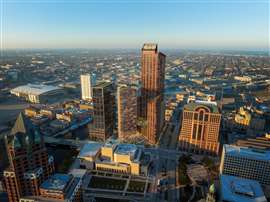 Render of a mass timber high-rise project in-development in Milwaukee, Wisconsin, US. (Image: Michael Green Architecture)
Render of a mass timber high-rise project in-development in Milwaukee, Wisconsin, US. (Image: Michael Green Architecture)
But while a materials war brews in discourse, and while the US softwood mill ecosystem develops, Microsoft’s sustainability leader for the data centre engineering team Jim Hanna said, “It’s an all-hands-on-deck approach.”
The company added, “Investments in low-carbon building materials – from concrete that permanently traps carbon dioxide to hydrogen-powered steel production – are being ramped up in a bid to accelerate commercial supply.
“To help reduce its future reliance on traditional steel, Microsoft last year became an investor in Sweden’s Stegra (formerly H2 Green Steel), which is building the ‘world’s first’ large-scale green steel plant in northern Sweden, with up to [an alleged] 95% reduction in carbon emissions compared to traditional steelmaking.”
CONTÁCTESE CON EL EQUIPO







